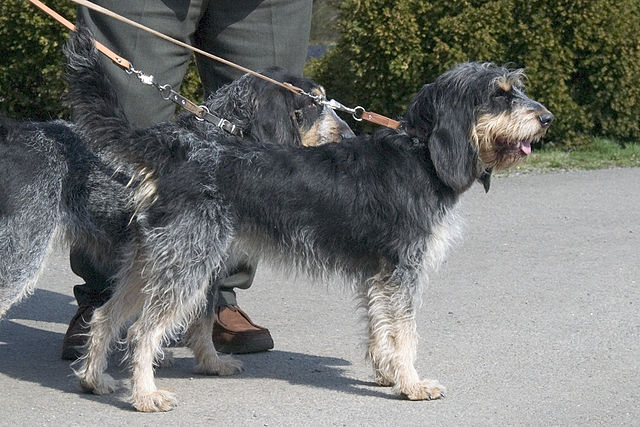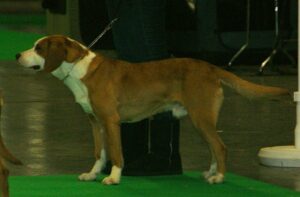The Griffon Bleu de Gascogne is one of four ancient Bleu de Gascogne breeds. All hailing from France, the Griffon is the wirehaired breed of the bunch. Like his cousins, he sports a speckled blue coat although the overall look is different because of the longer, rough hair. For a period of time, population numbers became very low and these scenthounds were faced with extinction. Today, while still a rare breed they are nonetheless growing in numbers (particularly in France and Spain). In the U.S., they are recognized by the UKC. In the past, these hound dogs hunted hare and wild boar and are still very keen hunting dogs today.
The Griffon Bleu was used to hunt both in packs, as well as individually. This means that most of them get along well with other dogs. Like other scenthounds, they have voices that carry well… and they use them freely – so city dwellers or those with close neighbors may want to think twice before acquiring one! They also have gifted noses which can be either a blessing (for those who want to hunt or do scent-related sports) or a curse (for those who don’t want a highly-distractable dog).
The Griffon Bleu is trainable and learns quickly, particularly if the lessons have anything whatsoever to do with hunting. This is a natural hunting dog that is easy to work with in that regard. With formal obedience training, he can be sensitive, independent and may take a bit longer to train than other breeds. Patience and consistency is key. This breed does not tend toward lavish shows of dominance and is usually willing to do what the owner/trainer wants, as long as he is shown the way. Make sure to be soft with him – he will shut down if shouted at or treated harshly! After the groundwork of obedience has been laid down, it is highly recommended to introduce nose-related dog sports such as tracking and/or nosework!
As a hunting scenthound, the Griffon Bleu does require extensive exercise in order to be happy. This exercise should be done on lead as he can (and will!) follow his nose to the closest animal/object to chase! On-lead jogging, long hikes, swimming, opportunities to hunt and/or scent-related games/sports are all great outlets for this energetic breed. Without his exercise needs being fulfilled, he will likely become destructive and frustrating to live with. Furthermore, this is a dog that does much better in a rural environment and will not thrive in an apartment or small home. This said, after his physical needs are met for the day he is often happy to lay on the couch next to his owner – he does enjoy indoor life.
The Griffon Bleu de Gascogne is loyal, affectionate and becomes very attached to his owner but can be high strung when excited (or when he hasn’t gotten enough exercise). While a lot of the time he can be fairly composed and peaceful, this is interjected with spurts of happy exuberance. He can be gentle with kids but his active nature means they can be accidentally knocked over. It may be best to wait until any children are older before introducing this breed to the home. With strangers, he is usually more cautious and needs plenty of socialization while young in order to build his confidence with them. It is normal for Bleus to bark at strangers when they first meet. Finally, unlike some of the more “drive-y” scenthound breeds, he can often live harmoniously with a cat as long as early introductions were done correctly.
The Griffon Bleu de Gascogne can be recognized by his medium sized frame, long hanging ears and of course his distinctive blue coat. The coat isn’t actually blue but instead is a mixture of black and white hair that comes together in such a way that it appears blue from a distance. Light tan markings on his face, legs and under the tail are also characteristic of the breed. The long tail is often held outward from the body and ends in a gentle curve. Finally, the eyes are a deep brown and, when combined with his eyebrows and beard, gives him an almost human-like expression.
The average lifespan of the Griffon Bleu de Gascogne is 13-14 years and they are generally a very healthy breed, staying active and alert for most of their lives. They don’t require a lot of grooming upkeep – only a weekly brushing and nail trim, and the occasional bath when needed. Once or twice a year, the coat should be plucked (have a groomer show you how) in order to keep the distinctive texture while still maintaining a neat and tidy appearance. Never shave this breed! The color will never be the same. Like most dogs with long hanging ears, they should be checked and cleaned regularly to avoid ear infections.




